Effect of Phenolics from Aeonium arboreum on Alpha Glucosidase, Pancreatic Lipase, and Oxidative Stress; a Bio-Guided Approach
Abstract
:1. Introduction
2. Methods and Materials
2.1. Plant Source and Authentication
2.2. Extraction, Fractionation, and Isolation of Major Phytochemicals
2.3. Characterization of Isolated Compounds
2.4. Biological Activity
2.4.1. Enzyme Inhibition
α-Glucosidase Enzyme Inhibition
Pancreatic Lipase Enzyme Inhibition
2.4.2. Antioxidant Activity
(2,2-Diphenyl-1-picrylhydrazyl) DPPH Assay
(2,2′-Azino-bis (3-ethylbenzothiazoline-6-sulfonic acid)) ABTS Assay
Ferric Reducing Antioxidant Power (FRAP) Assay
Oxygen Radical Absorbance Capacity (ORAC) Assay
Metal Chelation Assay
2.4.3. Data Analysis
2.5. Molecular Docking Simulations
2.5.1. Preparation of Target Protein Structure
2.5.2. Preparation of Tested Drug Molecules
2.5.3. Validation of Docking
2.6. Molecular Dynamic Simulations
2.7. Swiss-ADME Studies
3. Results and Discussion
3.1. Isolation of Major Phytochemicals
3.2. Biological Activity
3.2.1. Enzyme Inhibition
α-Glucosidase Enzyme Inhibition
Pancreatic Lipase Enzyme Inhibition
3.2.2. Antioxidant Activity
3.3. Molecular Docking Simulations
3.4. Molecular Dynamic Simulation
3.5. Swiss-ADME Studies
4. Conclusions
Supplementary Materials
Author Contributions
Funding
Institutional Review Board Statement
Informed Consent Statement
Data Availability Statement
Acknowledgments
Conflicts of Interest
References
- Sakulnarmrat, K.; Konczak, I. Composition of native Australian herbs polyphenolic-rich fractions and in vitro inhibitory activities against key enzymes relevant to metabolic syndrome. Food Chem. 2012, 134, 1011–1019. [Google Scholar] [CrossRef]
- Belete, R.; Ataro, Z.; Abdu, A.; Sheleme, M. Global prevalence of metabolic syndrome among patients with type I diabetes mellitus: A systematic review and meta-analysis. Diabetol. Metab. Syndr. 2021, 13, 25. [Google Scholar] [CrossRef] [PubMed]
- Saklayen, M.G. The global epidemic of the metabolic syndrome. Curr. Hypertens. Rep. 2018, 20, 12. [Google Scholar] [CrossRef] [PubMed]
- Song, F.; Schmidt, A.M. Glycation and insulin resistance: Novel mechanisms and unique targets? Arterioscler. Thromb. Vasc. Biol. 2012, 32, 1760–1765. [Google Scholar] [CrossRef] [PubMed]
- Abdallah, H.M.; Kashegari, A.T.; Shalabi, A.A.; Darwish, K.M.; El-Halawany, A.M.; Algandaby, M.M.; Ibrahim, S.R.; Mohamed, G.A.; Abdel-Naim, A.B.; Koshak, A.E. Phenolics from Chrozophora oblongifolia Aerial Parts as Inhibitors of α-Glucosidases and Advanced Glycation End Products: In-Vitro Assessment, Molecular Docking and Dynamics Studies. Biology 2022, 11, 762. [Google Scholar] [CrossRef]
- Prasad, H.; Ryan, D.N.; Celzo, M.F.; Stapleton, D. Metabolic syndrome: Definition and therapeutic implications. Postgrad. Med. 2012, 124, 21–30. [Google Scholar] [CrossRef]
- Delgado, H.; Lehmann, T.; Bobbioni-Harsch, E.; Ybarra, J.; Golay, A. Acarbose improves indirectly both insulin resistance and secretion in obese type 2 diabetic patients. Diabetes Metab. 2002, 28, 195–200. [Google Scholar]
- Liu, T.-T.; Liu, X.-T.; Chen, Q.-X.; Shi, Y. Lipase inhibitors for obesity: A review. Biomed. Pharmacother. 2020, 128, 110314. [Google Scholar] [CrossRef]
- Whaley-Connell, A.; McCullough, P.A.; Sowers, J.R. The role of oxidative stress in the metabolic syndrome. Rev. Cardiovasc. Med. 2011, 12, 21–29. [Google Scholar] [CrossRef]
- Huang, D.; Ou, B.; Prior, R.L. The chemistry behind antioxidant capacity assays. J. Agric. Food Chem. 2005, 53, 1841–1856. [Google Scholar] [CrossRef]
- Milagro, F.I.; Campión, J.; Cordero, P.; Goyenechea, E.; GGómez-Uriz, A.M.; Abete, I.; Zulet, M.A.; Martínez, J.A. A dual epigenomic approach for the search of obesity biomarkers: DNA methylation in relation to diet-induced weight loss. FASEB J. 2011, 25, 1378–1389. [Google Scholar] [CrossRef]
- Fan, W.; Huang, Y.; Zheng, H.; Li, S.; Li, Z.; Yuan, L.; Cheng, X.; He, C.; Sun, J. Ginsenosides for the treatment of metabolic syndrome and cardiovascular diseases: Pharmacology and mechanisms. Biomed. Pharmacother. 2020, 132, 110915. [Google Scholar] [CrossRef] [PubMed]
- Och, A.; Och, M.; Nowak, R.; Podgórska, D.; Podgórski, R. Berberine, a herbal metabolite in the metabolic syndrome: The risk factors, course, and consequences of the disease. Molecules 2022, 27, 1351. [Google Scholar] [CrossRef] [PubMed]
- Joseph, B.; Jini, D. Antidiabetic effects of Momordica charantia (bitter melon) and its medicinal potency. Asian Pac. J. Trop. Dis. 2013, 3, 93–102. [Google Scholar] [CrossRef]
- Qin, B.; Panickar, K.S.; Anderson, R.A. Cinnamon: Potential role in the prevention of insulin resistance, metabolic syndrome, and type 2 diabetes. J. Diabetes Sci. Technol. 2010, 4, 685–693. [Google Scholar] [CrossRef] [PubMed]
- Hewlings, S.J.; Kalman, D.S. Curcumin: A review of its effects on human health. Foods 2017, 6, 92. [Google Scholar] [CrossRef] [PubMed]
- Eggli, U. Illustrated Handbook of Succulent Plants: Crassulaceae; Springer Science & Business Media: Berlin/Heidelberg, Germany, 2012. [Google Scholar]
- Choucry, M.; Gonaid, M.; Ezzat, S.M.; Eid, O. Crassulaceae (chemistry and pharmacology)—A review. Future J. Pharm. Sci. 2018, 4, 234–240. [Google Scholar]
- Kennedy, M.L. Phytochemical profile of the stems of Aeonium lindleyi. Rev. Bras. De Farmacogn. 2012, 22, 676–679. [Google Scholar] [CrossRef]
- Hassan, M.H.; Elwekeel, A.; Moawad, A.; Afifi, N.; Amin, E.; El Amir, D. Phytochemical constituents and biological activity of selected genera of family Crassulaceae: A review. S. Afr. J. Bot. 2021, 141, 383–404. [Google Scholar] [CrossRef]
- Affes, S.; Ben Younes, A.; Frikha, D.; Allouche, N.; Treilhou, M.; Tene, N.; Mezghani-Jarraya, R. ESI-MS/MS analysis of phenolic compounds from Aeonium arboreum leaf extracts and evaluation of their antioxidant and antimicrobial activities. Molecules 2021, 26, 4338. [Google Scholar] [CrossRef]
- McConkey, B.J.; Sobolev, V.; Edelman, M. The performance of current methods in ligand–protein docking. Curr. Sci. 2002, 83, 845–856. [Google Scholar]
- Gutiérrez-Grijalva, E.P.; Antunes-Ricardo, M.; Acosta-Estrada, B.A.; Gutiérrez-Uribe, J.A.; Heredia, J.B. Cellular antioxidant activity and in vitro inhibition of α-glucosidase, α-amylase and pancreatic lipase of oregano polyphenols under simulated gastrointestinal digestion. Food Res. Int. 2019, 116, 676–686. [Google Scholar] [CrossRef] [PubMed]
- Kordel, M.; Schmid, R.D. Inhibition of the lipase from Pseudomonas spec. ATCC 21808 by diethyl p-nitrophenylphosphate. Hints for one buried active site for lipolytic and esterolytic activity. Lipases Struct. Mech. Genet. Eng. 1991, 16, 385–387. [Google Scholar]
- Faitanin, R.D.; Gomes, J.V.; Rodrigues, P.M.; de Menezes, L.F.T.; Neto, Á.C.; Gonçalves, R.C.; Kitagawa, R.R.; Silveira, D.; Jamal, C.M. Chemical study and evaluation of antioxidant activity and α-glucosidase inhibition of Myrciaria strigipes O. Berg (Myrtaceae). J. Appl. Pharm. Sci. 2018, 8, 120–125. [Google Scholar]
- Benzie, I.F.; Strain, J.J. The ferric reducing ability of plasma (FRAP) as a measure of “antioxidant power”: The FRAP assay. Anal. Biochem. 1996, 239, 70–76. [Google Scholar] [CrossRef] [PubMed]
- Liang, Z.; Cheng, L.; Zhong, G.-Y.; Liu, R.H. Antioxidant and antiproliferative activities of twenty-four Vitis vinifera grapes. PLoS ONE 2014, 9, e105146. [Google Scholar] [CrossRef]
- Santos, J.S.; Brizola, V.R.A.; Granato, D. High-throughput assay comparison and standardization for metal chelating capacity screening: A proposal and application. Food Chem. 2017, 214, 515–522. [Google Scholar] [CrossRef]
- Molecular Operating Environment (MOE). 2019.0102 Chemical Computing Group ULC. Montreal, QC, Canada, 2023. [Google Scholar]
- López-Blanco, J.R.; Aliaga, J.I.; Quintana-Ortí, E.S.; Chacón, P. iMODS: Internal coordinates normal mode analysis server. Nucleic Acids Res. 2014, 42, W271–W276. [Google Scholar] [CrossRef]
- Daina, A.; Michielin, O.; Zoete, V. SwissADME: A free web tool to evaluate pharmacokinetics, drug-likeness and medicinal chemistry friendliness of small molecules. Sci. Rep. 2017, 7, 42717. [Google Scholar] [CrossRef]
- Gohar, A.A.; El-Olemy, M.; Abdel-Sattar, E.; El-Said, M.; Niwa, M. Cardenolides and ß-sitosterol glucoside from Pergularia tomentosa L. Nat. Prod. Sci. 2000, 6, 142–146. [Google Scholar]
- Yang, M.H.; Luo, J.G.; Huang, X.F.; Kong, L.Y. Flavonol glycosides with α-D-aldohexoses from Rhododendron irroratum. Nat. Prod. Res. 2010, 24, 920–925. [Google Scholar] [CrossRef]
- Rodríguez, P.; González-Mujica, F.; Bermúdez, J.; Hasegawa, M. Inhibition of glucose intestinal absorption by kaempferol 3-O-α-rhamnoside purified from Bauhinia megalandra leaves. Fitoterapia 2010, 81, 1220–1223. [Google Scholar] [CrossRef] [PubMed]
- Mridula, S.; Masroor, W.S.; Xavier, M.; Hui, T.W.; Chan, H.K.; Chirara, K.; Nwabueze, O.P. Antioxidant and anti-advanced glycation end products formation properties of palmatine. J. Pharm. Pharmacogn. Res. 2021, 9, 366–378. [Google Scholar] [CrossRef]
- Albano, C.; Negro, C.; Tommasi, N.; Gerardi, C.; Mita, G.; Miceli, A.; De Bellis, L.; Blando, F. Betalains, phenols and antioxidant capacity in cactus pear [Opuntia ficus-indica (L.) Mill.] fruits from Apulia (South Italy) genotypes. Antioxidants 2015, 4, 269–280. [Google Scholar] [CrossRef]
- Opitz, S.E.; Smrke, S.; Goodman, B.A.; Keller, M.; Schenker, S.; Yeretzian, C. Antioxidant generation during coffee roasting: A comparison and interpretation from three complementary assays. Foods 2014, 3, 586–604. [Google Scholar] [CrossRef] [PubMed]
- Liang, N.; Kitts, D.D. Antioxidant property of coffee components: Assessment of methods that define mechanisms of action. Molecules 2014, 19, 19180–19208. [Google Scholar] [CrossRef]
- Subbiah, V.; Zhong, B.; Nawaz, M.A.; Barrow, C.J.; Dunshea, F.R.; Suleria, H.A. Screening of phenolic compounds in Australian grown berries by LC-ESI-QTOF-MS/MS and determination of their antioxidant potential. Antioxidants 2020, 10, 26. [Google Scholar] [CrossRef]
- Ren, L.; Qin, X.; Cao, X.; Wang, L.; Bai, F.; Bai, G.; Shen, Y. Structural insight into substrate specificity of human intestinal maltase-glucoamylase. Protein Cell 2011, 2, 827–836. [Google Scholar] [CrossRef]
- Sim, L.; Quezada-Calvillo, R.; Sterchi, E.E.; Nichols, B.L.; Rose, D.R. Human intestinal maltase–glucoamylase: Crystal structure of the N-terminal catalytic subunit and basis of inhibition and substrate specificity. J. Mol. Biol. 2008, 375, 782–792. [Google Scholar] [CrossRef]
- Mentreddy, S.R. Medicinal plant species with potential antidiabetic properties. J. Sci. Food Agric. 2007, 87, 743–750. [Google Scholar] [CrossRef]
- Leung, L.; Birtwhistle, R.; Kotecha, J.; Hannah, S.; Cuthbertson, S. Anti-diabetic and hypoglycaemic effects of Momordica charantia (bitter melon): A mini review. Br. J. Nutr. 2009, 102, 1703–1708. [Google Scholar] [CrossRef] [PubMed]
- Batch, J.T.; Lamsal, S.P.; Adkins, M.; Sultan, S.; Ramirez, M.N. Advantages and disadvantages of the ketogenic diet: A review article. Cureus 2020, 12, e9639. [Google Scholar] [CrossRef] [PubMed]
- Kumar, S.; Behl, T.; Sachdeva, M.; Sehgal, A.; Kumari, S.; Kumar, A.; Kaur, G.; Yadav, H.N.; Bungau, S. Implicating the effect of ketogenic diet as a preventive measure to obesity and diabetes mellitus. Life Sci. 2021, 264, 118661. [Google Scholar] [CrossRef] [PubMed]
- Das, S.S.; Bharadwaj, P.; Bilal, M.; Barani, M.; Rahdar, A.; Taboada, P.; Bungau, S.; Kyzas, G.Z. Stimuli-responsive polymeric nanocarriers for drug delivery, imaging, and theragnosis. Polymers 2020, 12, 1397. [Google Scholar] [CrossRef] [PubMed]
- Peter, E.L.; Sesaazi, C.D. D-optimal mixture design optimized solid formulation containing fruits extracts of Momordica charantia and Abelmoschus esculentus. PLoS ONE 2022, 17, e0270547. [Google Scholar] [CrossRef] [PubMed]
- Judy, W.V.; Hari, S.P.; Stogsdill, W.; Judy, J.S.; Naguib, Y.M.; Passwater, R. Antidiabetic activity of a standardized extract (Glucosol™) from Lagerstroemia speciosa leaves in Type II diabetics: A dose-dependence study. J. Ethnopharmacol. 2003, 87, 115–117. [Google Scholar] [CrossRef]
- Gudise, V.; Chowdhury, B.; Manjappa, A.S. Antidiabetic and antihyperlipidemic effects of Argyreia pierreana and Matelea denticulata: Higher activity of the micellar nanoformulation over the crude extract. J. Tradit. Complement. Med. 2021, 11, 259–267. [Google Scholar] [CrossRef]
- Odei-Addo, F.; Shegokar, R.; Müller, R.H.; Levendal, R.; Frost, C. Nanoformulation of Leonotis leonurus to improve its bioavailability as a potential antidiabetic drug. 3 Biotech 2017, 7, 344. [Google Scholar] [CrossRef]
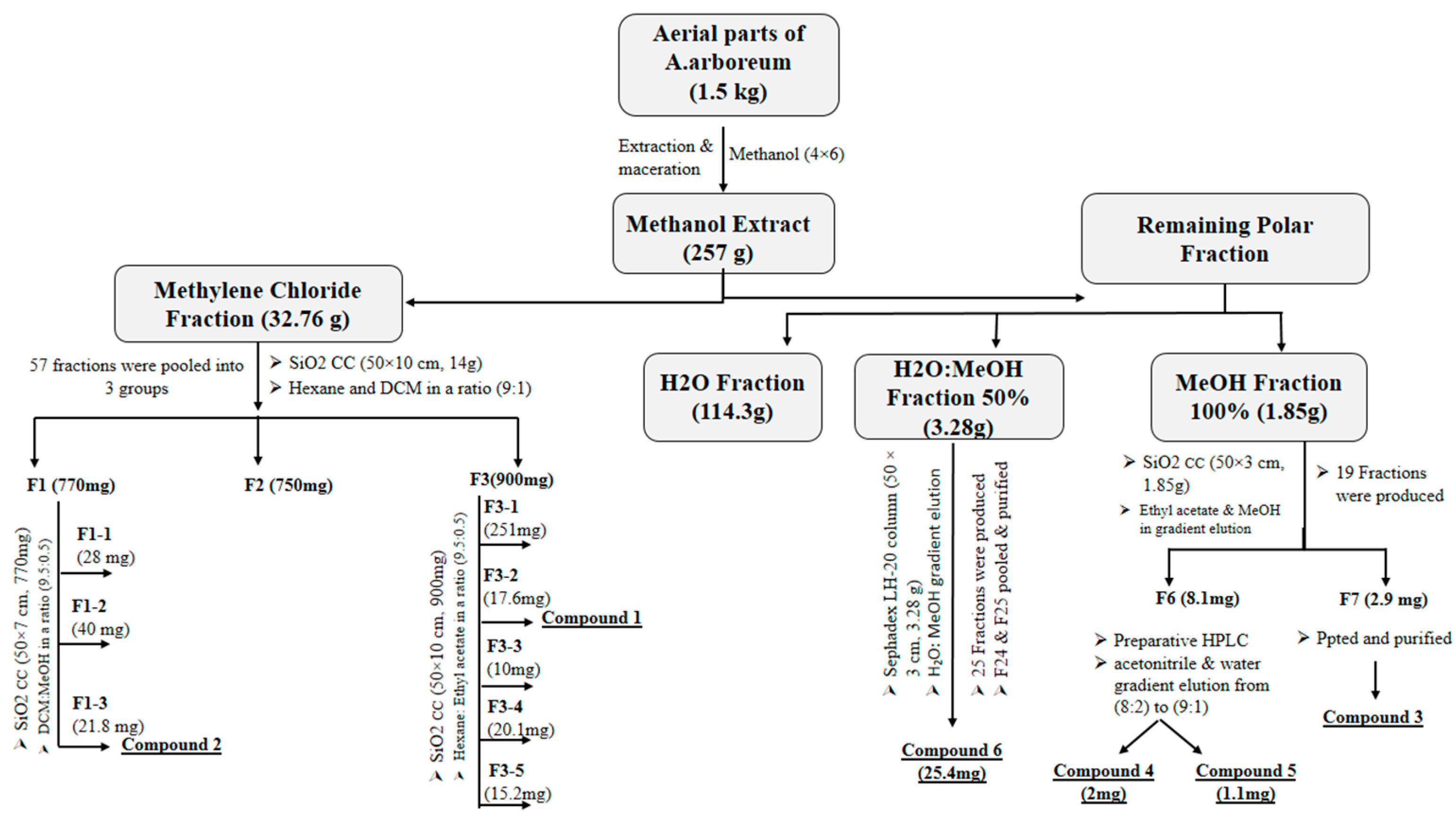
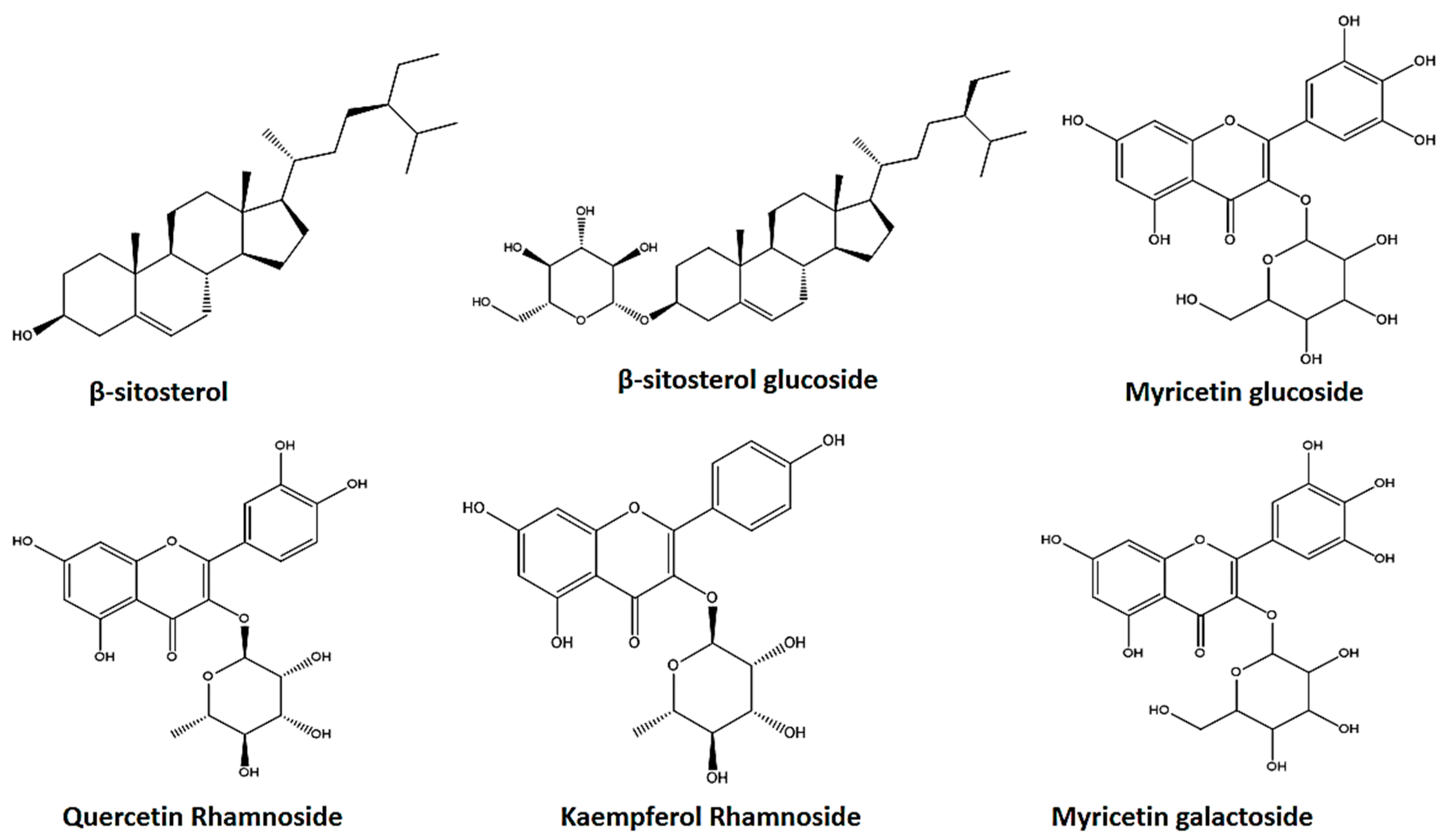
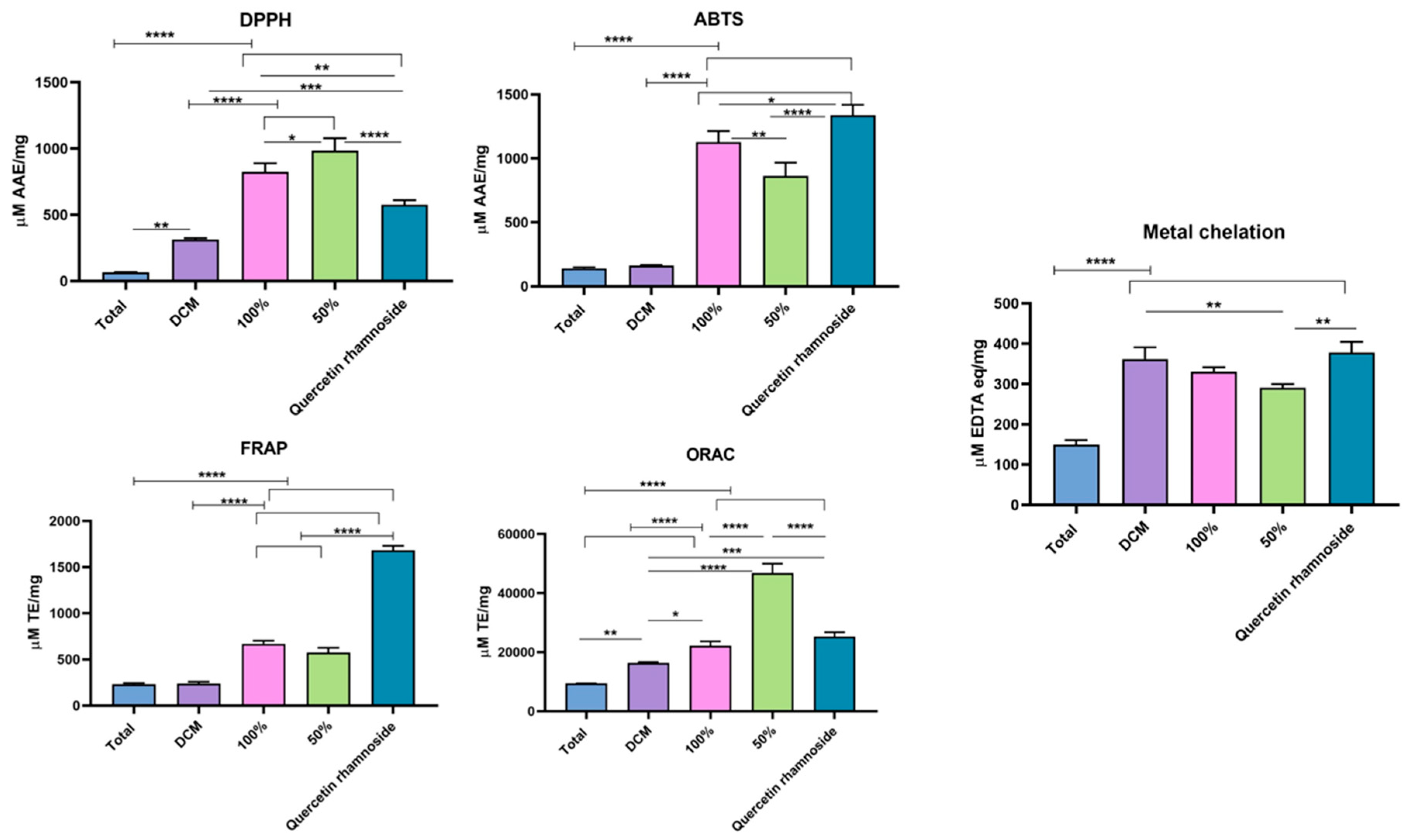

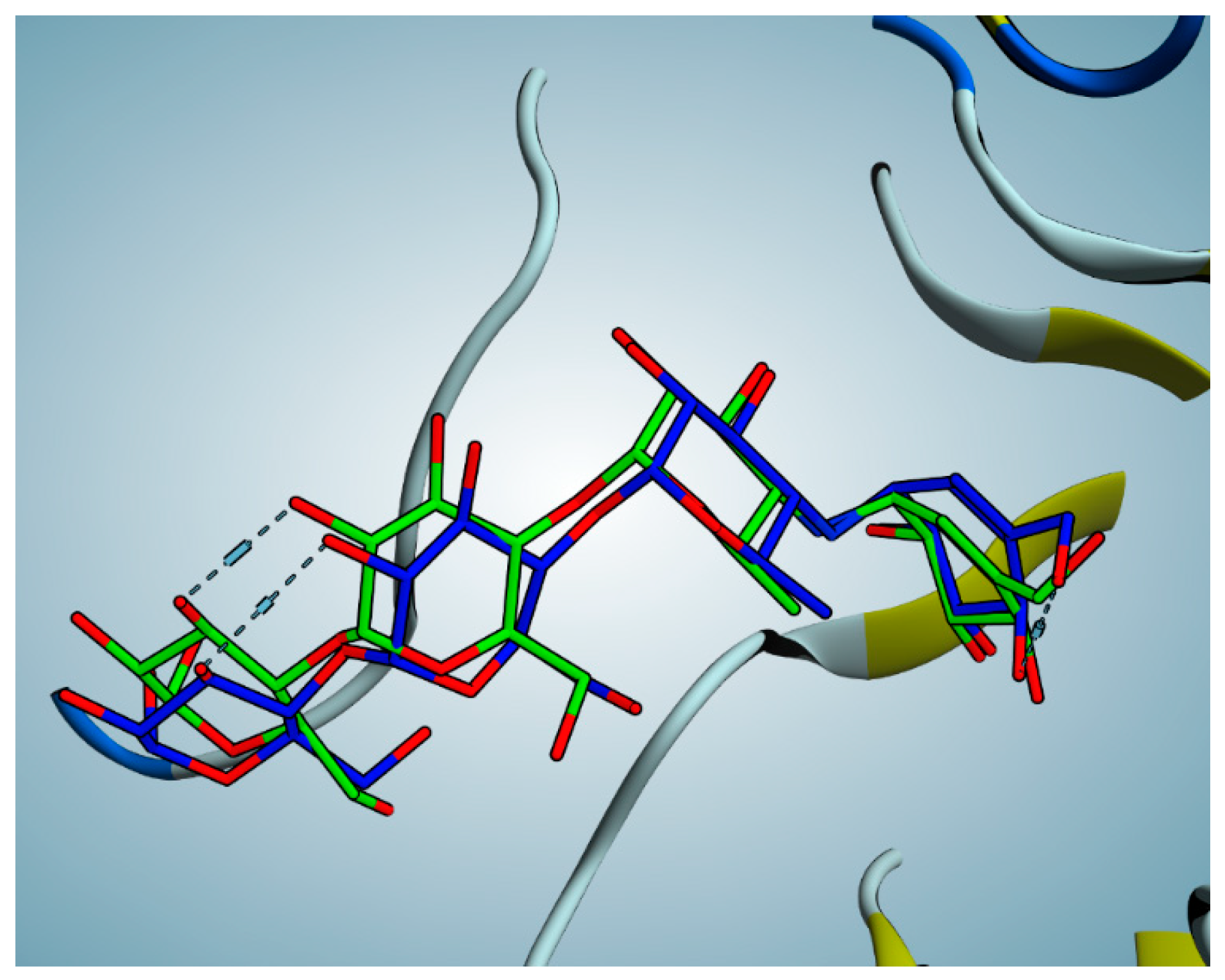
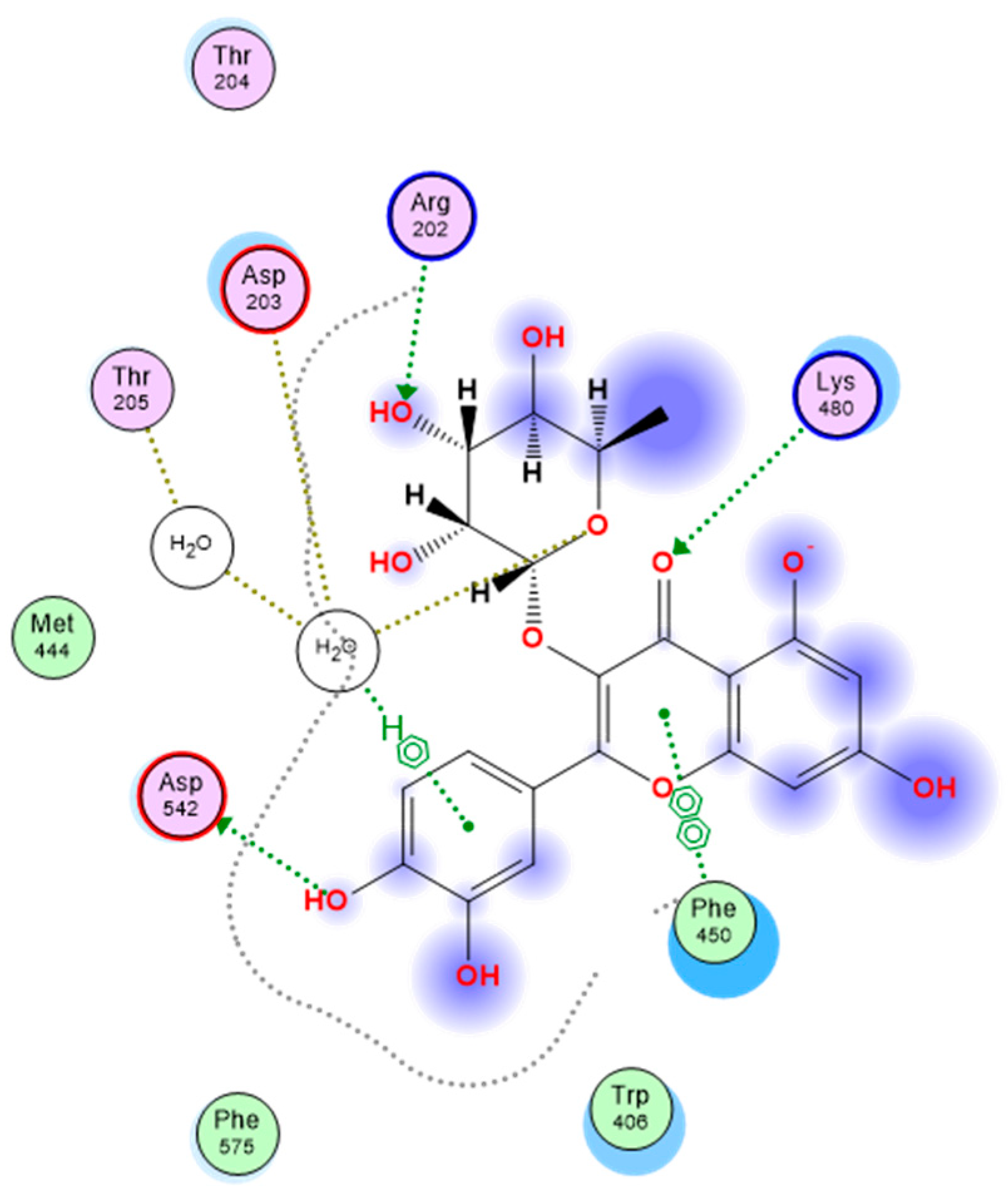
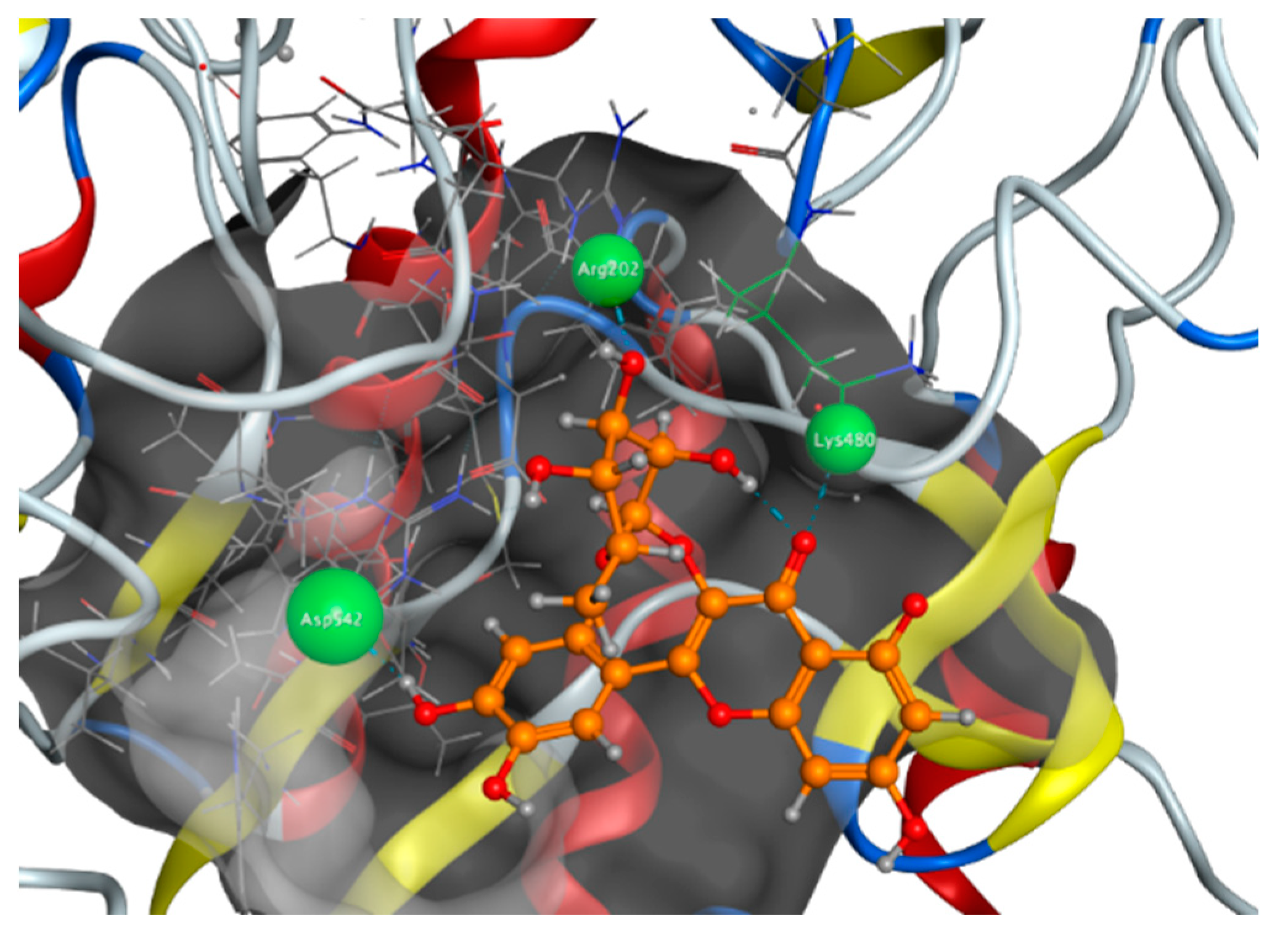
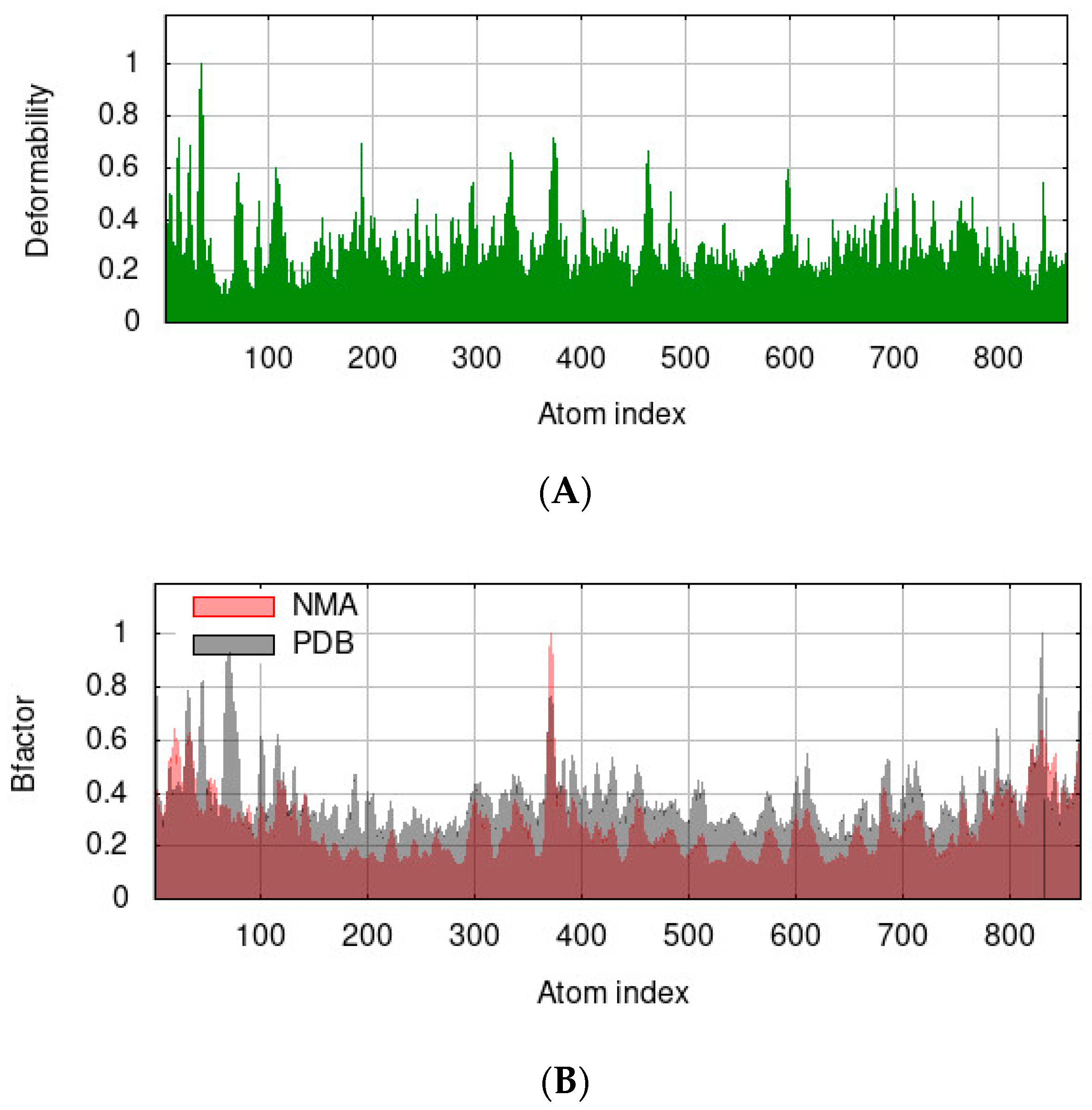
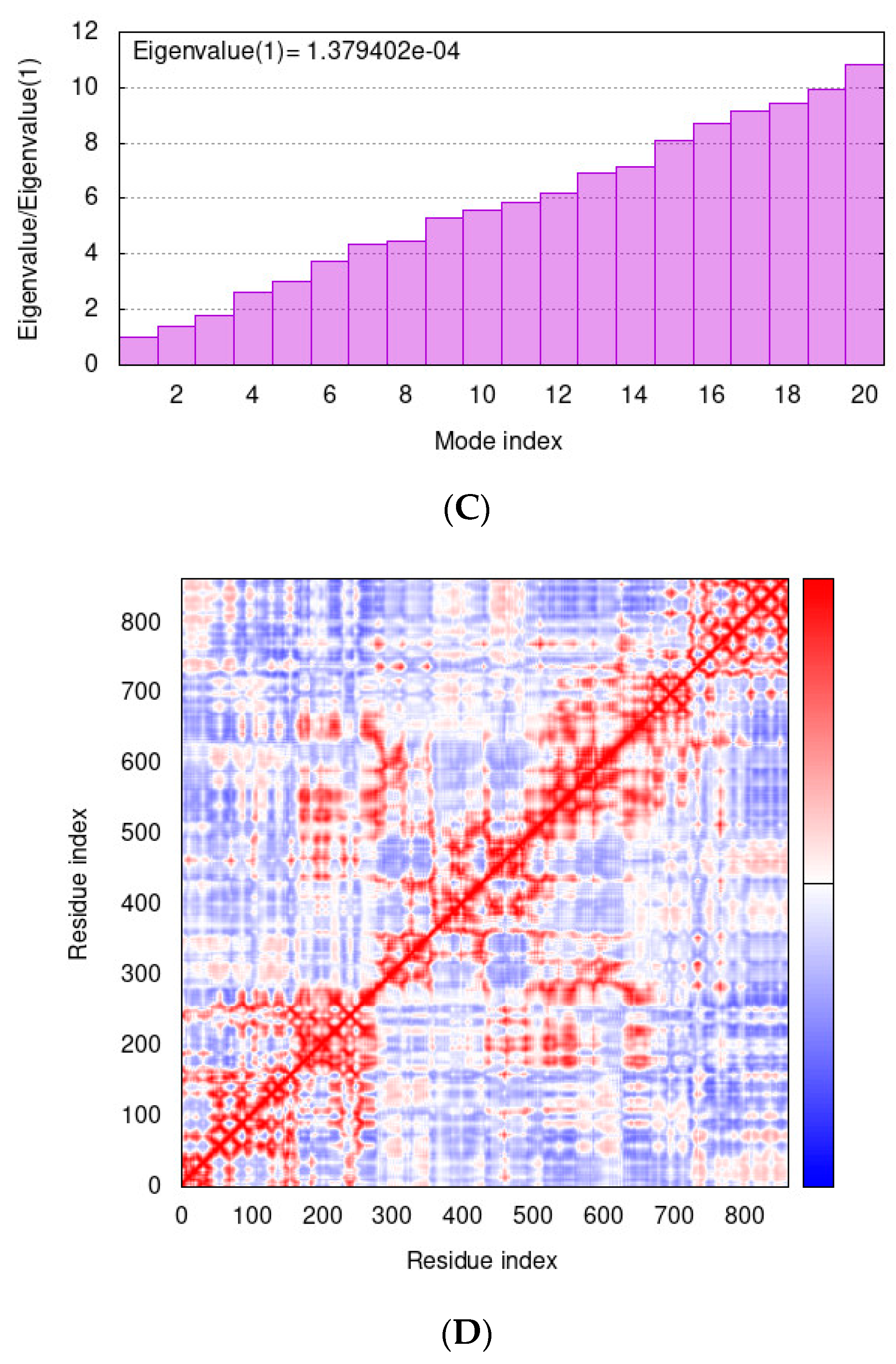
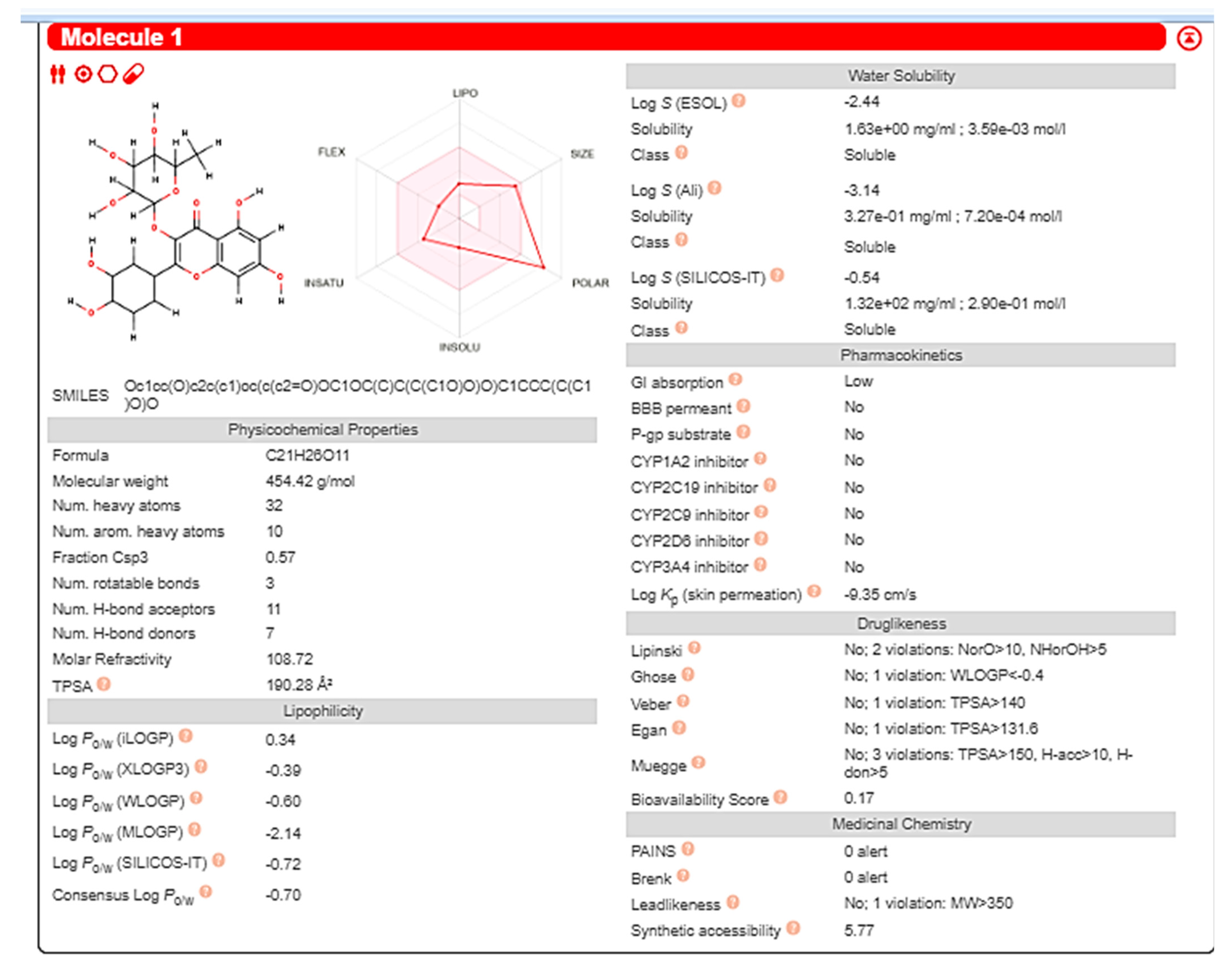
| Sample | IC50 (Mean ± SE) |
|---|---|
| MeOH extract | >1000 µg/mL |
| DCM fraction | 147.90 ± 1.03 µg/mL |
| 100% MeOH Diaion fraction | 48.24 ± 1.02µg/mL |
| 50% MeOH Diaion fraction | 44.26 ± 1.06 µg/mL |
| Quercetin-3-rhamnoside | 126.40 ± 1.04 µM |
| Acarbose | 161.40 ± 1.05 µM |
| Sample | % Inhibition (Mean ± SD) (500 µg/mL or µM) | IC50 (µM) (Mean ± SE) |
|---|---|---|
| MeOH extract | NO | ≥500 µg/mL |
| DCM fraction | 23.05 ± 1.05 | ≥500 µg/mL |
| 100% MeOH Diaion fraction | 9.43 ± 0.32 | ≥500 µg/mL |
| 50% MeOH Diaion fraction | 4.88 ± 0.55 | ≥500 µg/mL |
| Quercetin-3-rhamnoside | 19.06 ± 0.34 | ≥500 µM |
| S-Score (kcal/mol) | Bond Length (Å), Involved Receptor Residues | Type of Bond Interaction | |
|---|---|---|---|
| Acarbose | −8.66 | 2.3 Å; His600 (sidechain NH/valienamine 4′-OH) | H-bonding |
| 2.3 Å; His600 (sidechain NH/valienamine 5′-OH) | |||
| 2.0 Å; Asp203 [sidechain C=O, 6-deoxyglucosyl 4′-OH | |||
| 2.1 Å; 164_; Thr205 (sidechain OH/+3 maltosyl 6′-OH) | |||
| 1.9 Å; Asp203 [sidechain C=O, 6-deoxyglucosyl 3′-OH] | |||
| 1.9 Å; Asp327 (sidechain C=O/valienamine 4′-OH) | |||
| 2.0 Å; Arg526 (sidechain =NHH/valienamine 6′-OH) | |||
| 1.9 Å; Asp542 (sidechain C=O/glycosidic linker NH) | |||
| Tyr299, Ile328, Ile364, Trp406, Trp441, Phe450, Trp539, Phe575, Ala576 | Hydrophobic Interaction |
Disclaimer/Publisher’s Note: The statements, opinions and data contained in all publications are solely those of the individual author(s) and contributor(s) and not of MDPI and/or the editor(s). MDPI and/or the editor(s) disclaim responsibility for any injury to people or property resulting from any ideas, methods, instructions or products referred to in the content. |
© 2023 by the authors. Licensee MDPI, Basel, Switzerland. This article is an open access article distributed under the terms and conditions of the Creative Commons Attribution (CC BY) license (https://creativecommons.org/licenses/by/4.0/).
Share and Cite
Alfeqy, M.M.; El-Hawary, S.S.; El-Halawany, A.M.; Rabeh, M.A.; Alshehri, S.A.; Serry, A.M.; Fahmy, H.A.; Ezzat, M.I. Effect of Phenolics from Aeonium arboreum on Alpha Glucosidase, Pancreatic Lipase, and Oxidative Stress; a Bio-Guided Approach. Pharmaceutics 2023, 15, 2541. https://doi.org/10.3390/pharmaceutics15112541
Alfeqy MM, El-Hawary SS, El-Halawany AM, Rabeh MA, Alshehri SA, Serry AM, Fahmy HA, Ezzat MI. Effect of Phenolics from Aeonium arboreum on Alpha Glucosidase, Pancreatic Lipase, and Oxidative Stress; a Bio-Guided Approach. Pharmaceutics. 2023; 15(11):2541. https://doi.org/10.3390/pharmaceutics15112541
Chicago/Turabian StyleAlfeqy, Marwah M., Seham S. El-Hawary, Ali M. El-Halawany, Mohamed A. Rabeh, Saad A. Alshehri, Aya M. Serry, Heba A. Fahmy, and Marwa. I. Ezzat. 2023. "Effect of Phenolics from Aeonium arboreum on Alpha Glucosidase, Pancreatic Lipase, and Oxidative Stress; a Bio-Guided Approach" Pharmaceutics 15, no. 11: 2541. https://doi.org/10.3390/pharmaceutics15112541
APA StyleAlfeqy, M. M., El-Hawary, S. S., El-Halawany, A. M., Rabeh, M. A., Alshehri, S. A., Serry, A. M., Fahmy, H. A., & Ezzat, M. I. (2023). Effect of Phenolics from Aeonium arboreum on Alpha Glucosidase, Pancreatic Lipase, and Oxidative Stress; a Bio-Guided Approach. Pharmaceutics, 15(11), 2541. https://doi.org/10.3390/pharmaceutics15112541







